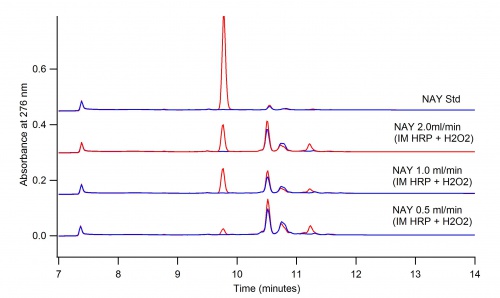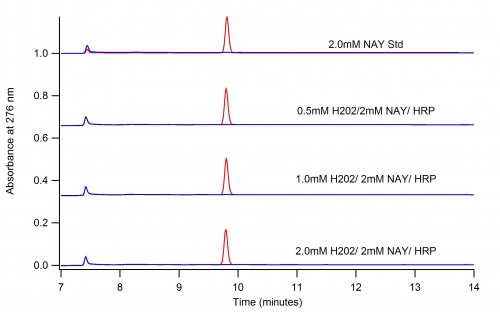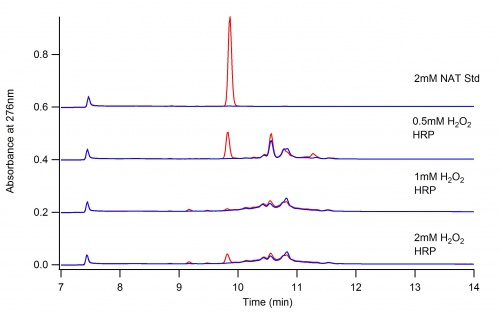Difference between revisions of "N-Acetyl L-Tyrosine"
Jump to navigation
Jump to search

Benstillwell (talk | contribs) |
Benstillwell (talk | contribs) |
||
| Line 4: | Line 4: | ||
==The Dioxane Conundrum== | ==The Dioxane Conundrum== | ||
The following two graphs depict the difference in reaction when dioxane is present and when it is not. The conclusion is that dioxane quenches oxidation of NAT. | The following two graphs depict the difference in reaction when dioxane is present and when it is not. The conclusion is that dioxane quenches oxidation of NAT. | ||
| − | [[File:NAY_trial_-3_6-6-2016.jpg|500px|thumb| | + | [[File:NAY_trial_-3_6-6-2016.jpg|500px|thumb|none|Figure 1: NAT oxidation in solution with dioxane and reacted with H2O2 and HRP 6/5/16. This graph shows the dioxane in the solution inhibiting the reaction completely. ]] |
[[file:NATw-oDioxane.jpg|500px|thumb|none|Figure 2: 2mM NAT oxidation without dioxane and reacted with 2mM H2O2 and HRP in a beaker 6/5/16]] | [[file:NATw-oDioxane.jpg|500px|thumb|none|Figure 2: 2mM NAT oxidation without dioxane and reacted with 2mM H2O2 and HRP in a beaker 6/5/16]] | ||
| Line 12: | Line 12: | ||
Utilizing the immobilization technique in a bio-reactor allows for the control of the rate of flow of the reaction. This makes the peaks in the products much more defined. | Utilizing the immobilization technique in a bio-reactor allows for the control of the rate of flow of the reaction. This makes the peaks in the products much more defined. | ||
| − | [[file:NATw-oDioxane.jpg|500px|thumb| | + | [[file:NATw-oDioxane.jpg|500px|thumb|none|Figure 2: 2mM NAT oxidation without dioxane and reacted with 2mM H2O2 and HRP in a beaker 6/5/16]] |
[[File:NAYIMHRP6-9.jpg|500px|thumb|none|Figure 3: 2mM NAT oxidation without dioxane and reacted with 1mM H2O2 using the [[Enzyme Immobilization|Immobilized Enzyme]] technique 6/9/16]] | [[File:NAYIMHRP6-9.jpg|500px|thumb|none|Figure 3: 2mM NAT oxidation without dioxane and reacted with 1mM H2O2 using the [[Enzyme Immobilization|Immobilized Enzyme]] technique 6/9/16]] | ||
| Line 20: | Line 20: | ||
==Concentration Test== | ==Concentration Test== | ||
| − | [[File:NEW69.jpg|500px|thumb| | + | [[File:NEW69.jpg|500px|thumb|none|Figure 4: 2mM NAT oxidation without dioxane and reacted with 1mM H2O2 and 2mM H202 with immobilized HRP at 0.5ml/min and 1.0ml/min 6/9/16]] |
[[File:KD9.jpg|500px|thumb|none|Figure 5: 10mM NAT oxidized with 5, 10, and 20mM H2O2 with immobilized HRP at 0.5ml/min 6/23/16]] | [[File:KD9.jpg|500px|thumb|none|Figure 5: 10mM NAT oxidized with 5, 10, and 20mM H2O2 with immobilized HRP at 0.5ml/min 6/23/16]] | ||
| Line 28: | Line 28: | ||
==Flash Chromatography== | ==Flash Chromatography== | ||
| − | [[File:DK 11.jpg|500px|thumb| | + | [[File:DK 11.jpg|500px|thumb|none|Figure 6: Flash chromatography separation of Figure 5 6/28/16]] |
Revision as of 17:47, 29 June 2016
This page depicts the oxidation of N-Acetyl L-Tyrosine (NAT) by Horse Radish Peroxidase (HRP)
The Dioxane Conundrum
The following two graphs depict the difference in reaction when dioxane is present and when it is not. The conclusion is that dioxane quenches oxidation of NAT.
Beaker Reaction vs. Immobilized Enzyme Bio-Reactor
Utilizing the immobilization technique in a bio-reactor allows for the control of the rate of flow of the reaction. This makes the peaks in the products much more defined.

Figure 3: 2mM NAT oxidation without dioxane and reacted with 1mM H2O2 using the Immobilized Enzyme technique 6/9/16
Concentration Test





